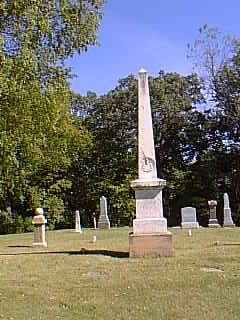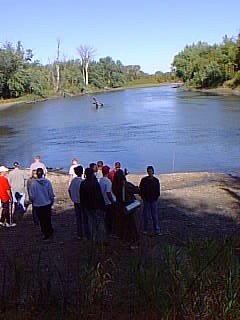

The men are buried in two trenches. From north to south on the west side the bodies are those of Nathan Stewart, Jacob A. Gehring, Charles E. French, Charles R. Bell, First Sergent R. H. Findley, Capt. John S. Marsh, Sergeant S. A. Trescott, Corporal J. S. Besse, Edwin F. Cole, John Gardner and Interpreter Peter Quinn. Form north to south on the east sid ethe bodies are thos of Nathaniel Pitcher, Harrison Phillips, John Parsley, John W. Parksm Moses P Parks, Wenzel Norton, James H. Kerr, Durs Kanzig, Christian Joerger, John Holmes and Charles W. Smith. the bodies of Wenzel Kusda, Henry McAllister and Henry A. Shepherd were never found but their names are on the monument, as is that of Mark M. Greer of Co. C. killed at the batte of Fort Ridgely. *
To commemorate and identify the scene of the ambush the Minnesota Valley Historical Society has erected a substantial granite monument at the side of the oldtime ferry landing, at the point, as nearly as could be determined, where Captain marsh and his men were first fired upon. " It is located on the U.S. Lot 3, section 5, south Birch Cooley. The site is now overgrown with small willow and other trees and the monument stands in a thicket. It is of sufficient proportions and so well set that it will endure for a century." The river frequently overflows its banks at this point, but the structure is so well placed on a secure foundation that it can not be washed away. The incription reads: "At and near this spot Capt. John Marsh and twenty-four men were ambushed and killed by Souix Indians, Aug. 18, 1862. Also Peter Quin, U.S. Interpreter." *